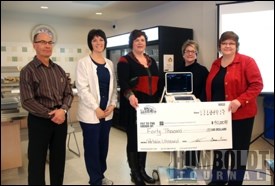With a new, cutting-edge ultrasound in its grasp, the Humboldt District Health Complex (HDHC) will no longer have to send patients home worried they missed something.
"Why wonder when you can know? Why listen when you can see?" said Laurie Brad Richards, clinical leader of the emergency room (ER) and outpatient department (OPD).
The new, portable ultrasound was received by HDHC on Dec. 11 at a total cost of $55,830. The Kinsmen Foundation donated $40,000 and the hospital was able to fundraise the balance.
"We looked at what the product was in terms of its innovation and its ability to be used productively," said Joan Steckham, executive director of the Kinsmen Foundation. "This piece is very important because if they can do a proper diagnosis, they will know if they need to send the patient to Saskatoon."According to Richards, conversations to acquire the technology began about a year and a half ago. This ultrasound was chosen for its unique ability to be continuously upgraded with newer features and compact size, making it portable. This will also eliminate the need for HDHC to obtain newer machines as technology advances.
Originally, HDHC only had one ultrasound that could be used before 4:30 p.m. on the weekdays. Should it be required after that time, patients had to travel to Saskatoon. Moreover, physicians were handicapped by their inability to see any irregularities beyond what they could hear with their stethoscopes.
"This machine is the most advanced portable ultrasound in Saskatchewan," said Edward Osborne, a sales representative ultrasound account manager for Esaote (the company that provided the machine). "It gives a visualization to clinical findings and is one of the newest developed, software-based technologies."
According to Osborne, the machine is the most recent piece of technology among ultrasound diagnostic medical systems. Esaote has improved the image quality to the point where it's no longer grainy and is clearer from near to far field. It maintains the ability to scan a heavyweight person as well as any small orifices or appendages, such as the ears or eyes.
"We're fortunate that some of the younger physicians have had exposure to this equipment," said Richards. "With this type of technology, they can deliver point-of-care assessment. They can use the machine not to diagnose, but to assess and then send along the results to be verified."
So far, HDHC has four physicians and one sonographer that are able to use the technology. In order for the other 11 to be able to use it, they will need to take a course to be certified. Unfortunately, the training is at a cost to each individual physician, both in terms of time and money.

.png;w=120;h=80;mode=crop)


